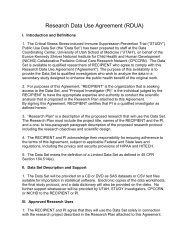CDC Definitions of Nosocomial Infections (PDF) - CPCCRN
CDC Definitions of Nosocomial Infections (PDF) - CPCCRN
CDC Definitions of Nosocomial Infections (PDF) - CPCCRN
You also want an ePaper? Increase the reach of your titles
YUMPU automatically turns print PDFs into web optimized ePapers that Google loves.
Chapter 94: Surveillance <strong>of</strong> <strong>Nosocomial</strong> <strong>Infections</strong> 1681symptoms with no other recognized cause: fever(38C), erythema <strong>of</strong> pharynx, sore throat,cough, hoarseness, <strong>of</strong> purulent exudate in throatandat least one <strong>of</strong> the following:a. Organisms cultured from the specific siteb. Organisms cultured from bloodc. Positive antigen test on blood or respiratorysecretionsd. Diagnostic single antibody titer (IgM) or fourfoldincrease in paired sera (IgG) for pathogene. Physician’s diagnosis <strong>of</strong> an upper respiratoryinfectionCriterion 2: Patient has an abscess seen on direct examination,during a surgical operation, or during a histopathologicexamination.Criterion 3: Patient 1 year <strong>of</strong> age has at least two <strong>of</strong> the followingsigns or symptoms with no other recognizedcause: fever (38C), hypothermia(37C), apnea, bradycardia, nasal discharge, orpurulent exudate in throatandat least one <strong>of</strong> the following:a. Organisms cultured from the specific siteb. Organisms cultured from bloodc. Positive antigen test on blood or respiratorysecretionsd. Diagnostic single antibody titer (IgM) or fourfoldincrease in paired sera (IgG) for pathogene. Physician’s diagnosis <strong>of</strong> an upper respiratoryinfectionINFECTION SITE: GastroenteritisCODE: GI-GEDEFINITION: Gastroenteritis must meet at least one <strong>of</strong> thefollowing criteria:Criterion 1: Patient has an acute onset <strong>of</strong> diarrhea (liquid stoolsfor more than 12 hours) with or without vomitingor fever (38C) and no likely noninfectiouscause (e.g., diagnostic tests, therapeutic regimen,acute exacerbation <strong>of</strong> a chronic condition, or psychologicstress).Criterion 2: Patient has at least two <strong>of</strong> the following signs orsymptoms with no other recognized cause: nausea,vomiting, abdominal pain, or headacheandat least one <strong>of</strong> the following:a. An enteric pathogen is cultured from stool orrectal swabb. An enteric pathogen is detected by routine orelectron microscopyc. An enteric pathogen is detected by antigen orantibody assay on blood or fecesd. Evidence <strong>of</strong> an enteric pathogen is detected bycytopathic changes in tissue culture (toxinassay)e. Diagnostic single antibody titer (IgM) or fourfoldincrease in paired sera (IgG) for pathogenINFECTION SITE: GI tract (esophagus, stomach, small andlarge bowel, and rectum) excluding gastroenteritis and appendicitisCODE: GI-GITDEFINITION: Gastrointestinal tract infections, excluding gastroenteritisand appendicitis, must meet at least one <strong>of</strong> the followingcriteria:Criterion 1: Patient has an abscess or other evidence <strong>of</strong> infectionseen during a surgical operation or histopathologicexamination.Criterion 2: Patient has at least two <strong>of</strong> the following signs orsymptoms with no other recognized cause andcompatible with infection <strong>of</strong> the organ or tissueinvolved: fever (38C), nausea, vomiting, abdominalpain, or tendernessandat least one <strong>of</strong> the following:a. Organisms cultured from drainage or tissue obtainedduring a surgical operation or endoscopyor from a surgically placed drainb. Organisms seen on Gram or KOH stain ormultinucleated giant cells seen on microscopicexamination <strong>of</strong> drainage or tissue obtained duringa surgical operation or endoscopy or froma surgically placed drainc. Organisms cultured from bloodd. Evidence <strong>of</strong> pathologic findings on radiologicexaminatione. Evidence <strong>of</strong> pathologic findings on endoscopicexamination (e.g., Candida esophagitis or proctitis)INFECTION SITE: HepatitisCODE: GI-HEPDEFINITION: Hepatitis must meet the following criterion:Patient has at least two <strong>of</strong> the following signs or symptoms withno other recognized cause: fever (38C), anorexia, nausea,vomiting, abdominal pain, jaundice, or history <strong>of</strong> transfusionwithin the previous 3 monthsandat least one <strong>of</strong> the following:a. Positive antigen or antibody test for hepatitisA, hepatitis B, hepatitis C, or delta hepatitisb. Abnormal liver function tests (e.g., elevated alanine/aspartateaminotransferases, bilirubin)c. Cytomegalovirus detected in urine or oropharyngealsecretionsREPORTING INSTRUCTIONS:Do not report hepatitis or jaundice <strong>of</strong> noninfectious origin(alpha-1 antitrypsin deficiency, etc.).Do not report hepatitis or jaundice that results from exposureto hepatotoxins (alcoholic or acetaminophen-induced hepatitis,etc.).Do not report hepatitis or jaundice that results from biliaryobstruction (cholecystitis).INFECTION SITE: Intraabdominal, including gallbladder, bileducts, liver (excluding viral hepatitis), spleen, pancreas, perito-



